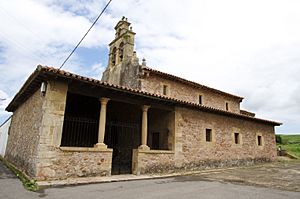Church of San Jorge (Manzaneda) facts for kids
Quick facts for kids Iglesia de San Jorge (Manzaneda) |
|
|---|---|
 |
|
| Location | Manzaneda, Gozón, Asturias |
| Country | Spain |
The Church of San Jorge of Manzaneda (in Spanish, la iglesia de San Jorge de Manzaneda) is a beautiful old church located in Gozón, Spain. Even though it is small, it is a great example of Asturian Romanesque architecture. This style of building was popular in Asturias, a region in northern Spain.
The church was built a very long time ago, between the late 1100s and early 1200s. It is special because of its unique design and how well its surroundings have stayed the same over hundreds of years.
Contents
What Makes the Church Special?
Church Design and Features
The Church of San Jorge is found near a town called Alvaré. It is about the same size as other country churches from the Romanesque period in Asturias. The church has a main room, called a nave, which is rectangular. This nave does not have any smaller sections or side chapels.
The front part of the church mixes two styles. One part uses ideas from local building traditions. The other part shows influences from international Roman designs.
Decorative Details
Many parts of the church show its Romanesque style through decorations. You can see patterns like zigzags. There is also a large arch with simple pictures or symbols. The apse, which is the rounded end of the church, has corbels. These are stone supports that stick out from the wall. They are carved with images of people and animals.
The church was built using mostly a type of stone called Sillarejo masonry. This means the walls are rough and uneven. This simple building style fits well with the local traditions. It also shows that there might not have been many resources when it was built.
Inside the Church
The ceiling of the church combines different old building ideas. The main room, the nave, has a wooden frame around its ceiling. At the front of the church, there is an arch. Behind this arch, the ceiling is shaped like a half-cylinder, called a barrel vault. Beyond that is a rounded area, known as a hemicycle.
We do not have many old documents about the church's construction. However, its age is clear from its style. The church's story is connected to the nearby Palace of Manzaneda. This palace was built in the 1600s around a much older medieval tower.
A Look at the Church's History
When Was It Built?
It is hard to know the exact date the Church of San Jorge was built because there are no written records from that time. However, experts believe it was constructed between the late 1100s and early 1200s. This is because it shows many features of the Asturian Romanesque style.
Changes Over Time
The church has been changed several times throughout its long history. But it is thought to still be about the same size as it was originally. Over the centuries, some small changes were made. For example, a window was added to the south apse. A doorway on the south side was closed up. Also, a bell gable, which is a wall with openings for bells, was added in 1774.
Damage and Restoration
Sadly, the church was badly damaged during a civil war in 1936. Much of what was inside the church was ruined. A big restoration project took place between 1942 and 1950. During this work, the upper parts of the nave walls were changed. The corbels that were once in that area were also removed.
See also
 In Spanish: Iglesia de San Jorge (Manzaneda) para niños
In Spanish: Iglesia de San Jorge (Manzaneda) para niños
- Asturian art
- Catholic Church in Spain

